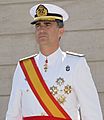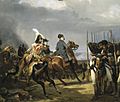Commander-in-Chief facts for kids
A commander-in-chief is the commander of a nation's military forces. Some country's commander-in-chief does not need to have been a soldier or involved in the military. The term was first used by King Charles I of England in 1639.
Commanders-in-Chief is sometimes referred to as Supreme Commander, which is sometimes used as a specific term.
Contents
Australia
The role of command in chief is done by the Governor-General of Australia as the Queen's representative.
United Kingdom
The title Commander-in-Chief is rarely used by the King or Queen of England, but usually refers to local commanders-in-chief.
India
After independence from Britain on August 15, 1947, each Service was given its own Chief Commander (navy, army, airforce).
Iran
Before 1979, the Shah was the commander-in-chief in Iran. After the creation of the Islamic Republic, the Supreme Leader of Iran has taken on the role.
Ireland
In Ireland, the commander-in-chief of the army is the President.
Pakistan
In Pakistan, the President is by law the Commander-in-Chief of the Armed Forces, however the elected Prime Minister has the real power.
Hong Kong
When Hong Kong was a British colony the Governor was also the Commander-in-Chief of Hong Kong.
United States of America
Commander-in-chief is one of the many roles given to the president of the United States
Images for kids
-
Argentine president Carlos Menem presiding over an Argentine Air Force ceremony for the Falklands War in May 1997.
-
Governor General of Australia The Lord Gowrie (right) signing the declaration of war against Japan with Prime Minister John Curtin (left) looking on. (8 December 1941)
-
President Alexander Lukashenko wearing the official uniform of the commander-in-Chief of the Armed Forces of Belarus.
-
Chairman of the Presidency of Bosnia and Herzegovina Alija Izetbegović (right) meeting with US president Bill Clinton (left) in 1997 in Tuzla.
-
King George VI inspects a Royal Canadian Navy guard of honour during the 1939 royal tour of Canada.
-
King Christian IV on board his flagship during the 1644 Battle of Colberger Heide, by Wilhelm Marstrand. The king's personal commitment during the battle, are memorialized in first lines of the Danish royal anthem.
-
C. G. E. Mannerheim, the Marshal of Finland, as the commander-in-chief in 1941 during the Continuation War
-
The ceremony of passing the Cheget (i.e. the nuclear briefcase) from Dmitry Medvedev's military aide to Vladimir Putin's military aide during the 2012 presidential inauguration.
-
Current President of South Korea, President Yoon Suk-yeol
-
King Felipe VI in uniform of Captain General of the Navy at the Naval NCO Academy in 2014.
-
Mareşal Mustafa Kemal Pasha (center), the president of Turkey with other generals of the Turkish Armed Forces in 1925.
-
Hugo Chavez, the president of Venezuela, dressed in military garb in August 2006.
-
New recruits standing in front of the Reichstag building, before taking the Bundeswehr oath. In the light of Prussian militarism and due to its infamous history of the 20th century; Germany of today puts a strong emphasis on having armed forces compatible with a parliamentary system.
-
Werner von Blomberg (left) saluting Adolf Hitler (right) with a baton at the 1937 Nuremberg Rally.
-
4-stars Flag-Insignia of Deputy Commander-in-Chief of Tatmadaw
-
The Royal insignia (Dutch: distinctief) worn by King Willem-Alexander, instead of a regular military rank, whenever he wears a Dutch military uniform.
-
The Swedish monarch (King Carl XVI Gustaf) is no longer the commander-in-chief of the Swedish Armed Forces, although he continues to receive treatment befitting a head of state.
-
Napoléon I, Emperor of the French, reviewing the Imperial Guard at the Battle of Jena-Auerstedt in 1806, by Horace Vernet.
See also
 In Spanish: Comandante en jefe para niños
In Spanish: Comandante en jefe para niños



















